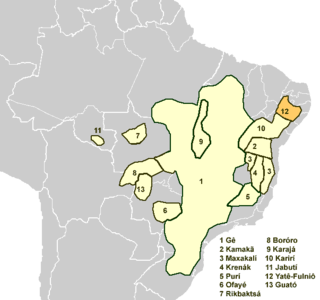

You can help expand this article with text translated from the corresponding article in Portuguese. (April 2021) Click [show] for important translation instructions.
|topic= will aid in categorization.Content in this edit is translated from the existing Portuguese Wikipedia article at [[:pt:Língua yatê]]; see its history for attribution.{{Translated|pt|Língua yatê}} to the talk page. |
| Yatê-Fulniô | |
|---|---|
| Native to | Brazil |
| Region | Águas Belas, Pernambuco |
Native speakers | 1,000 (2011)[1] |
| |
| Dialects |
|
| Language codes | |
| ISO 639-3 | fun |
| Glottolog | fuln1247 |
| ELP | Yaté |
 | |
| This article contains IPA phonetic symbols. Without proper rendering support, you may see question marks, boxes, or other symbols instead of Unicode characters. For an introductory guide on IPA symbols, see Help:IPA. | |
Fulniô, or Yatê, is a language isolateofBrazil, and the only indigenous language remaining in the northeastern part of that country. The two dialects, Fulniô and Yatê, are very close. The Fulniô dialect is used primarily during a three-month religious retreat. Today, the language is spoken in Águas Belas, Pernambuco.[2]
The language is also called Carnijó, and alternate spellings are Fornió, Furniô, Yahthe, and Iatê.
Kaufman (1990) classified Fulniô as one of the Macro-Gê languages. However, Eduardo Ribeiro of the University of Chicago, who is working on large-scale classification of Brazilian languages, finds no evidence to support this, and treats it as an isolate. Jolkesky (2016) again has it as Macro-Je, but Nikulin (2020) again excludes it.
Fulniô has the following sounds:
| Labial | Alveolar | Post- alveolar |
Palatal | Velar | Glottal | ||
|---|---|---|---|---|---|---|---|
| Nasal | m | n | |||||
| Plosive | plain | p | t d | k | |||
| aspirated | pʰ | tʰ | kʰ | ||||
| Affricate | plain | ts | tʃ dʒ | ||||
| aspirated | tsʰ | tʃʰ | |||||
| Fricative | f | s z | ʃ | h | |||
| Approximate | l | j | w | ||||
/pʰ/ is rare.
Fulniô has 8 vowels.
| Front | Central | Back | |
|---|---|---|---|
| Closed | i | u | |
| Near-close | ɪ | ||
| Close-mid | e | o | |
| Open-mid | ɔ | ||
| Open | æ | a |
There are few contrasts between /o/ and /u/, suggesting /u/ is a recent addition, perhaps from Portuguese.
All seven have nasalized and glottalized allophones, depending on adjacent consonants. Vowels occur long and short. However, long vowels result from assimilation of /h/, are pronounced [Vh] in one dialect, and so are analyzed as /Vh/ sequences.
Tones are high and low. Contour tones occur allophonically adjacent to voiced consonants. Final syllables tend to lack a tone contrast, and final vowels may be devoiced or dropped.
There are no vowel sequences; vowels either coalesce or are separated by a glottal stop. Consonant clusters are limited to two consonants, apart from a possible additional /j w/, with the maximum syllable being CCCVC; reduced vowels between consonants are analyzed as /j w/ by Meland & Meland: /tfàltʰùlkja/ 'crossing over', /kwlèlja/ 'rotten'.
Loukotka (1968) lists the following basic vocabulary items.[3]
| gloss | Fulnio |
|---|---|
| head | i-tká |
| eye | itó |
| tooth | dzyashi |
| foot | ishiri |
| water | oya |
| fire | toːwẽ |
| star | tiúyá |
| maize | malchi |
| jaguar | kléken |
| black | chichiá |
Some Yaathê words given by Nikulin (2020),[4]: 69–70 cited from Lapenda (1965,[5] 2005 [1968][6]), Barbosa (1991),[7] Costa (1999),[8] F. Silva (2011a,[9] 2011b[10]), and Branner (1887).[11]
| Portuguese gloss (original) |
English gloss (translated) |
Yaathê |
|---|---|---|
| cinza | ashes | fêlôwa |
| pé | foot | fêhê |
| folha | leaf | ta(-)cʰa |
| fígado | liver | ta(-)cô |
| dente | tooth | ta(-)xi |
| cabelo | hair | li |
| água | water | ôːja |
| língua | tongue | kts(ʰ)ale |
| boca | mouth | ta(-)tʰê |
| nariz | nose | kʰletʰa |
| olho | eye | tʰô |
| orelha | ear | kfakê |
| cabeça | head | tkʰa |
| fogo | fire | tôwê |
| árvore | tree | cʰleka |
| semente | seed | kêtʰôja |
| ouvir | hear | kfala- |
| dormir | sleep | kfafa- |
| terra | earth | fê(j)ʔa |
| piolho | louse | cfôwa |
| pedra | stone | fô(ʔ)a |
| chuva | rain | flicja |
| mão | hand | koho ~ kʰoja (?) |
| caminho | road | tdi |
| dar | give | kô- |
| estar sentado | be seated | kine- |
| estar deitado | lying down | kʰa- |
| ir | go | o-, no- |
| rabo | tail | ta(-)tô |
| carne | meat | ucʰi ~ utxi |
| nome | name | ketkʲa |
| unha | nail (finger) | kʰôtkʲa |
|
| |
|---|---|
| Families |
|
| Isolatesorunclassified |
|
| Proposed groupings |
|
|
| |||||||||||||||||||||||||||||||
|---|---|---|---|---|---|---|---|---|---|---|---|---|---|---|---|---|---|---|---|---|---|---|---|---|---|---|---|---|---|---|---|
| Language families and isolates |
| ||||||||||||||||||||||||||||||
| Proposed groupings |
| ||||||||||||||||||||||||||||||
| Linguistic areas |
| ||||||||||||||||||||||||||||||
| Countries |
| ||||||||||||||||||||||||||||||
| Lists |
| ||||||||||||||||||||||||||||||